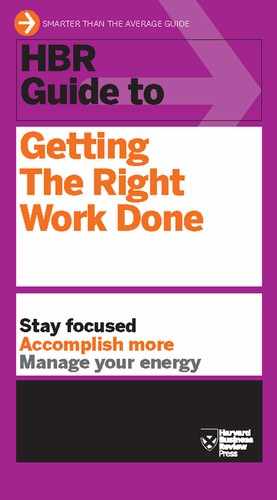Chapter 19
An 18-Minute Plan for Managing Your Day
by Peter Bregman
I began my day yesterday with the best intentions. I walked into my office in the morning with a vague sense of what I wanted to accomplish. Then I sat down, turned on my computer, and checked my e-mail. Two hours later, after fighting several fires, solving other people’s problems, and dealing with whatever happened to be thrown at me through my computer and phone, I could hardly remember what I had originally set out to do.
Most of us start every day knowing we’re not going to get it all done. So how we spend our time is a key strategic decision. That’s why it’s a good idea to create both a to-do list and a to-don’t list.
But even with those lists, the challenge—as always—is execution. How can you stick to a plan when so many things threaten to derail it? How can you focus on just a few important tasks when so many others require your attention?
We need a trick.
Jack LaLanne, the fitness guru, knew all about tricks. He had one trick that I believe was his real secret power.
Ritual.
At the age of 94, he still spent the first two hours of his day exercising. Ninety minutes lifting weights and 30 minutes swimming or walking. Every morning. He needed to do so to achieve his goals: on his 95th birthday he planned to swim from the coast of California to Santa Catalina Island—a distance of 20 miles.
So he worked consistently and deliberately. He did the same things day in and day out. He cared about his fitness and he built it into his schedule.
Managing our time needs to become a ritual, too. Not simply a list or a vague sense of our priorities. That’s not consistent or deliberate. It needs to be an ongoing process we follow, no matter what, to keep us focused on our priorities throughout the day.
We can do it in three steps that take fewer than 18 minutes over an eight-hour workday:
- (5 minutes): Set Your Plan for the Day. Before turning on your computer, sit down with a blank piece of paper and decide what will make this day highly successful. What can you realistically accomplish that will further your goals and allow you to leave at the end of the day feeling productive? Write those things down. Now, most important, take your calendar and schedule those things into time slots, placing the hardest and most important items at the beginning of the day—before checking your e-mail. If your entire list doesn’t fit into your calendar, reprioritize your list. There is tremendous power in deciding when you’re going to do something. (See “How to Tackle Your To-Do List,” earlier in this guide.)
- (1 minute every hour): Refocus. Set your watch, phone, or computer to ring every hour. When it rings, take a deep breath, look at your list, and ask yourself: Am I doing what I most need to be doing right now? Then look at your calendar and deliberately recommit to how you’re going to use the next hour. Manage your day hour by hour. Don’t let the hours—or the inevitable interruptions—manage you.
- (5 minutes at end of day): Review. Shut off your computer and review your day. What worked? Where did you focus? Where did you get distracted? What did you learn that will help you be more productive tomorrow?
The power of rituals is their predictability: You do the same thing in the same way over and over again. And the outcome of a ritual is predictable, too. If you choose your focus deliberately and wisely and consistently remind yourself of that focus, you will stay focused.
This particular ritual may not help you swim 20 miles through the ocean or live to be 100. But it may just help you leave your office feeling productive and successful. And, at the end of the day, isn’t that a higher priority?
____________
Peter Bregman is a strategic adviser to CEOs and their leadership teams. His latest book is 18 Minutes: Find Your Focus, Master Distraction, and Get the Right Things Done.
